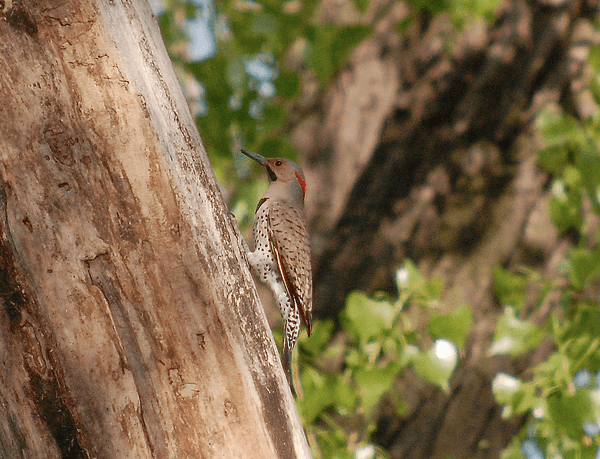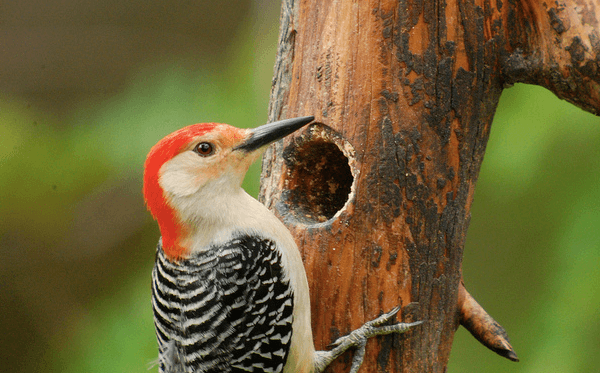Short answer: The woodpecker is most likely not crazy and noshing on the house is not what the woodpecker has in mind. Woodpeckers could be pecking on homes for a variety of reasons, all of which can drive a non birder a bit batty.
Talk about pesky, a Northern Flicker like the bird above liked to peck foam off of the space shuttle. Yikes! So, why do woodpeckers peck on human made structures?
Reason 1: Territory
This is the time of year when a variety of birds are setting up breeding territories. There are several species of birds we enjoy for their songs–American Robins, Carolina Wrens, Wood Thrushes and maybe even Red-winged Blackbirds. Woodpeckers aren’t known for their musical song and quite frankly, that’s not what brings the ladies in. Woodpeckers aren’t the lead singers of the band…they are the drummers. And that’s what they do to get female attention. Woodpeckers like to use something that is loud and will resonate…usually a hollow tree. But sometimes a gutter will work just as well. Here’s a Yellow-bellied Sapsucker using a gutter drain:
httpv://www.youtube.com/watch?v=I3mgqqmugPU&feature=related
Reason 2: Nesting
If a woodpecker is making large holes, they could be creating a roosting spot or a cavity to raise a family of young woodpeckers. This is something that should be dealt with early. You don’t want to discover a wall full of peckers and have to wait until the brood fledges to patch it up…you run the risk of forgetting it and even worse have starling take it over after the woodpeckers leave.
Reason 3: Food
Sometimes woodpeckers will make several small holes, this is a sign that they are searching for food. Some say they are able to hear larvae of leaf cutter bees chewing in gaps in cedar siding and peck at the sounds of the larvae. If you leave small holes unattended, that will serve as a beacon to other woodpeckers that someone saw the area as a source of food and make more holes. You could end up with a minor problem…or you could end up with a really big Acorn Woodpecker problem.
Uh oh…the feeder’s empty…that Red-bellied Woodpecker could be eying your house…
For any of these problems, you need act fast and you need to be persistent. The most important thing that you need to know is that plastic fake owls do not work. Plastic owls do not move and birds figure out that they are fake quite quickly…apart from the odd Cooper’s Hawk. You need something shiny or even better yet, you need something mobile, something that is randomly mobile or mobile and noisy as soon as the woodpecker shows up.
Some people try using insecticidal paint, especially when woodpeckers are making small holes to get at insects, but that needs to be reapplied often–sometimes once every year or every two years.
The older thinking used to be using red shiny mylar strips hanging off of your home. For those who dig recycling, you could hang old CDs from Jesus Jones or the Spice Girls on wire (okay, band isn’t important, but I will be super disappointed if anyone hangs a Bowie CD…unless it’s Tin Machine, no one would blame you for that).
The new fangled idea these days is to use something called a Scare Spider. My guess is that some Halloween shop had an excessive amount of these motion sensitive spiders left, an employee had a woodpecker problem and put then put two and tow together like chocolate and peanut butter with hopeful results. The idea is that a woodpecker flies up, a big hairy spider drops down and the bird flies away–badda bing, badda boom…woodpecker scared away. I think you could the same effect if have one of those old singing Billy Basses sitting in a garage or attic.
If you want the ultimate solution, switch to aluminum siding and remember deal with it quickly…especially if you live an an area with Acorn Woodpeckers.















Great capture!
I have recently recorded common flameback woodpeckers building their new nest:
http://youtu.be/C9uCE8joUis
After spending thousands of dollars repairing Flicker damage to our cedar siding, we ended up hanging netting from the eaves on three sides of our house. We made sure to secure the edges so no small birds become stuck inside. It’s a bit of a hassle, but so far, not one woodpecker hole (at least on those three sides). You can read the whole story at http://blogs.icta.net/plover/2009/03/09/flickers/ and the follow up (about the netting solution) at http://blogs.icta.net/plover/2009/03/12/foiling-flickers/.
I saw the spiders at the local bird store, but didn’t think they’d survive the rain, snow, sleet and hail we get every spring.
Check out the HUGE HOLES the Pileated Woodpeckers are making in big dead trees on my land this year! (http://rooster613.blogspot.com/2011/04/pileated-woodpecker-action-on-dead.html) None of these are banging on the house (thank goodness!) but there is a Downy who likes to drum on some old sheet metal scrap out behind the chicken coop. Makes quite a racket — hope it impresses the lady Downies.
@Leslie
Holy cow, I can only imagine what that flicker did. That’s a creative solution for keeping them off. I’ve heard of using netting for keeping birds off of windows, but not woodpeckers. Thank you for taking the time to find a peaceful/non fatal/illegal solution to your woodpecker problem!
@Yonassan Wow!
We have woodpeckers, cardinals and the occasional robin attacking our motorhome bright and early. The campground is heavily wooded, in Northern Baltimore Co., MD. The cardinals and robins are focused on the big mirrors, and the woodpecker is just “lustily” hammering away on the rig itself. My husband is trying to train our labrador to chase them off, but the dog likes the beat. We may have to install a spider if the birds don’t get their hormones under control. Thanks for the information.
Hope someone can tell me what kind of black bird has white geometrical lines on it’s back.
Great article. And I love the way you write! Entertaining AND Educational.
One of the red-bellied woodpeckers here found out he could make waaay more noise pounding on a yard art tin man in my back yard. He moves around till he finds the noisiest part. Too funny.
The window frames and sills of the Santa Rita Lodge in Madera Canyon, Az., are used by the Acorn Woodpeckers as a food store. They peck the hole, then ram in the acorn. Makes for a great alarm clock!